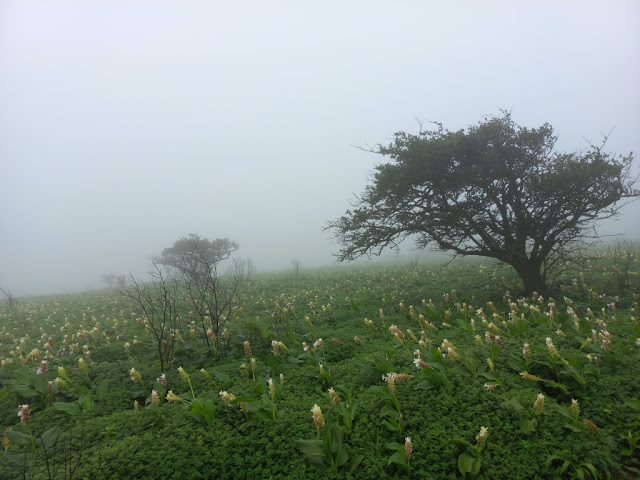Kas Plateau Reserved Forest, Satara, Maharashtra
Kas Plateau Reserved Forest, also known as the Kaas Pathar, is a plateau made from volcanic rocks situated in Kaas Village near Satara City in Satara District of Maharashtra, India. It is famously called as Kaas plateau of flowers. It falls under the Sahyadri Sub Cluster of the Western Ghats, and it became a part of a UNESCO World Natural Heritage Site in 2012. It is a biodiversity hotspot known for various types of seasonal wild flowers bloom and numerous species of endemic butterflies annually in the months of August and September.
The Kaas
Plateau
The plateau is situated at an altitude of 1200 metres and is approximately 10 square kilometers in area. The flora of kaas are typically restricted to that particular locality only. This is because the plateau is largely formed of basalt which is directly exposed to atmosphere. The basalt is almost covered entirely by a thin cover of soil formed due to erosion and has accumulated a layer of not more than 25 mm or so. Kaas has more than 850 different species of flowering plants. 624 species have entered in the Red Data Book. Out of these 624 species, 39 are found only in Kaas Region. The flora of kaas include orchids, shrubs such as the Karvy, and carnivorous plants such as Drosera Indica. The orchids bloom here for a period of 3 – 4 weeks during monsoon season.
Some of the most common flowering plants are Adenoon indicum, Aerids maculosum, Aponogeton satarensis, Arisaema murrayi, Begonia crenata, Ceropegia jainii, Ceropegia vincifolia, Ceropegia media, Chlorophytum glaucoides, Cyanotis tuberosa, Dendrobium barbatulum, Dioscorea bulbifera, Dipcadi montanum, Drosera burmanni, Drosera indica, Elaeocarpus glandulosus, Exacum tetragonum, Flemingia nilgheriensis, Habenaria grandifloriformis, Habenaria heyneana, Habenaria longicorniculata, Habenaria panchganiensis, Hitchenia caulina, Impatiens oppositifolia, Ipomoea barlerioides, Linum mysurense, Memecylon umbellatum, Murdannia lanuginosa, Murdannia simplex, Nymphoides indicum, Oberonia recurva, Paracaryopsis coelestina, Paracaryopsis malbarica, Pinda concanensis, Pogostemon deccanensis, Rotala fimbriata, Rotala ritchiei, Senecio bombyensis, Senecio grahami, Smithia agharkarii, Smithia hirsute, Trichosanthes tricuspidata, Utricularia purpurascens, Vigna vexillata, Wild Brinjal flower etc.
The plateau also has several invertebrates throughout the year. Tiger beetles are observed mating in large numbers on Kas during September–October. Praying mantises, ants are common. Tadpole shrimps were reported some years back. Fairy shrimps are present in the small pond. The plateau has several signs of presence of barking deers, Gaur, hares, civets and rodents. Ruddy mongoose, Rusty spotted cat have been observed in surrounding scrub area. Presence of Leopard has been reported from the surrounding forest area. Endemic Malabar Lark is commonly observed nesting on the rocky plateau. This is also a haven for bird watchers, as many species of birds can be spotted here. The major portion of the plateau is reserve Forest.
Kaas lake is situated on the south of the Kaas Plateau and is surrounded by dense forest. Kaas lake is a perennial source of water supply for western part of Satara city by gravity. Kaas Plateau overlooks the dense evergreen forests of the Koyna Wildlife Sanctuary and serves as the catchment area of the Koyna Dam. To control possible damage by tourists, the number of visitors to the plateau has been restricted to 3,000 per day. The best time to visit Kas Pathar is from August to October. Many people visit Kaas during the rains; however, the plants bloom only in late August to September. Bhambavli Flower Plateau, largest flower plateau of the world is situated 3 kms away from Kaas Plateau. Bhambavli Vajrai Waterfall is also near Kaas which is one of India's highest waterfalls.
Fees
·
Entry Fee: Rs. 100 /- (No
entry fees Children below age 5 years)
·
Bicycle Charges: Rs. 50/- per 1
hour (Deposit Necessary)
·
Guide Charges for group of
10: Rs. 100/-.
Connectivity
Kaas Pathar is located at about 4 Kms from Kaas, 24 Kms
from Satara Bus Stand, 25 Kms from Satara, 30 Kms from Satara Railway Station,
38 Kms from Mahabaleshwar, 50 Kms from Panchgani, 50 Kms from Tapola and 145
Kms from Pune Airport. There are two ways to reach Kaas. One is the direct way
from Satara and another from Tapola via the link road connecting Mahabaleshwar and
Panchgani to Kas Pathar.





.jpg)






















.jpg)















.jpg)







